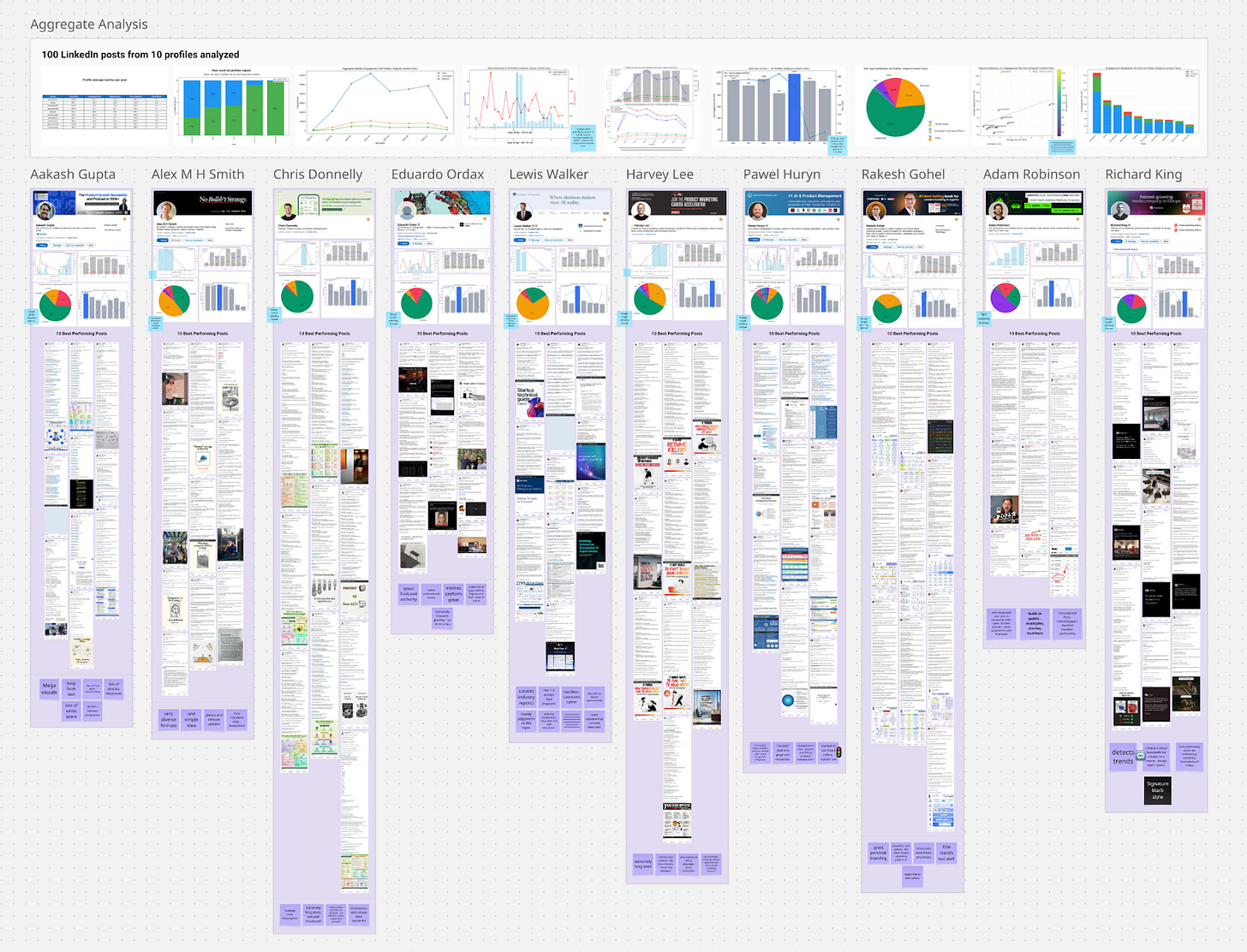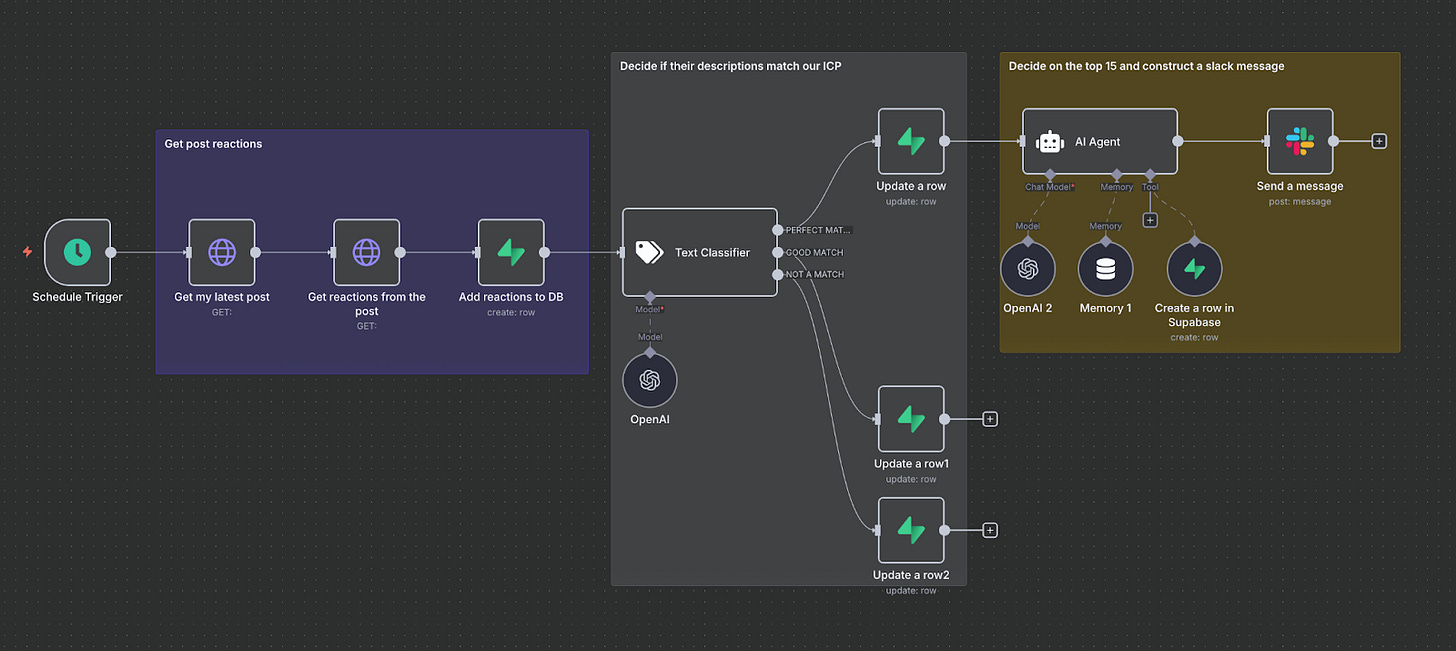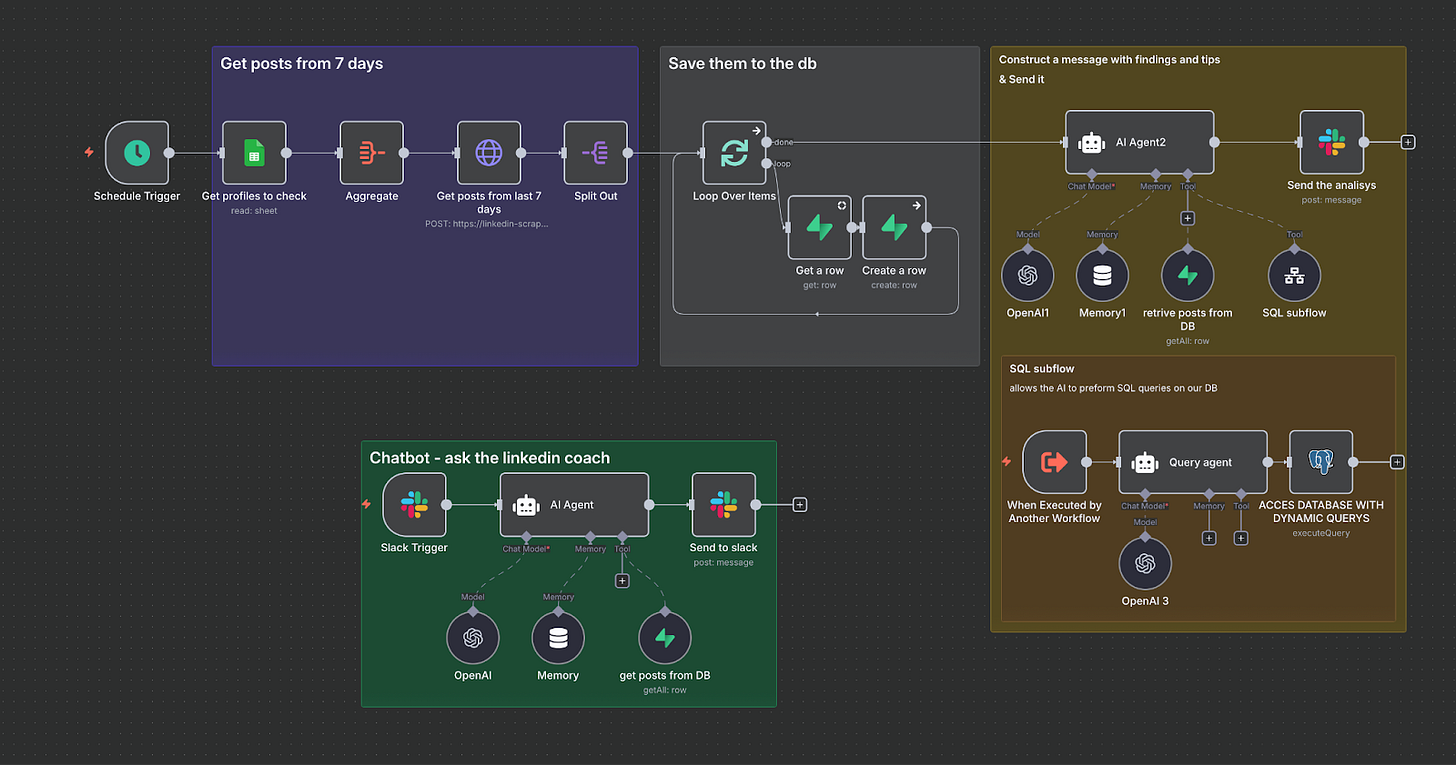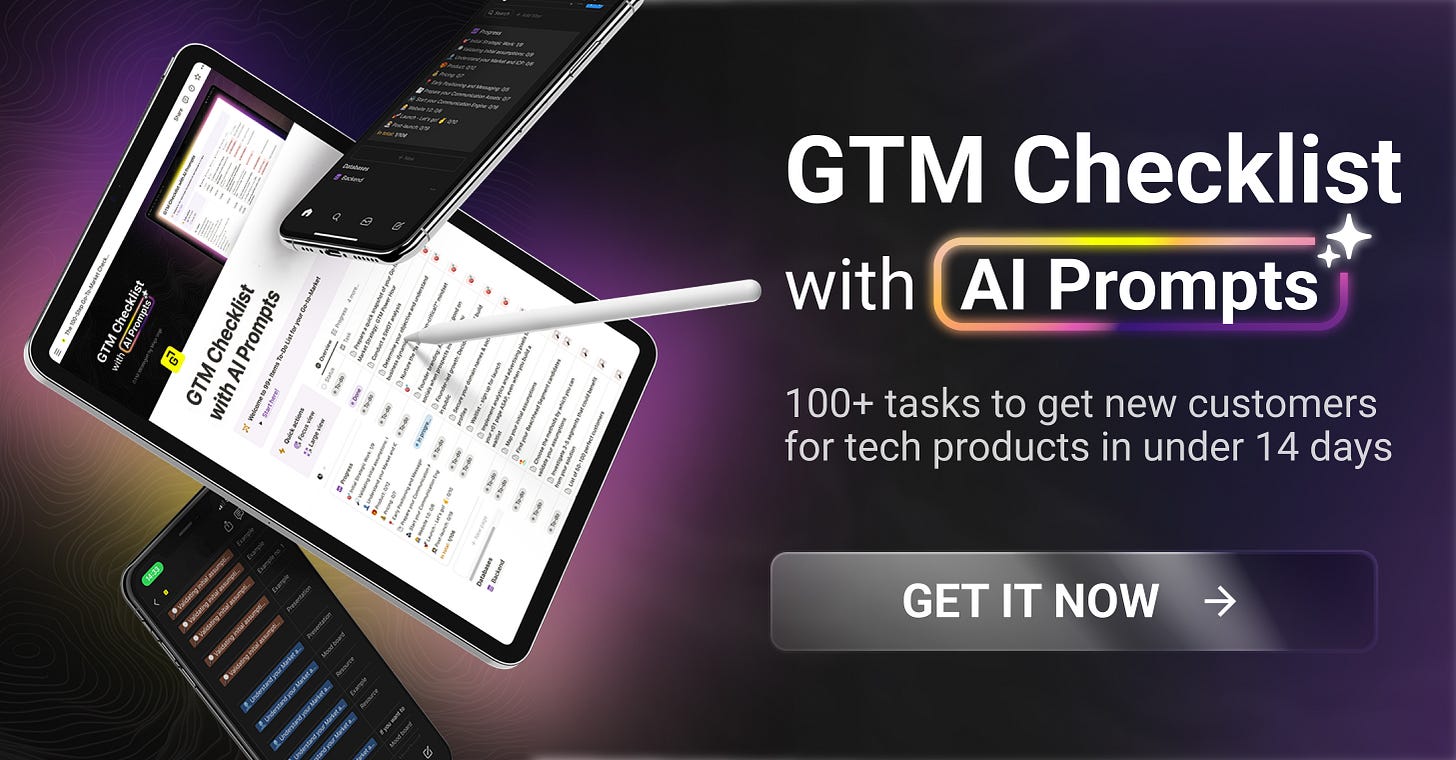4 AI Agents for LinkedIn: Research, Engagement, ICP Extractor and Coach
My team did some vibe coding in n8n
Dear GTM Strategist!
We spent some amazing time in the United States attending the Miro Canvas 25 event, learning about AI from frontrunners in the space. Miro just launched Sidekicks, MCPs and Flows (demos coming soon!), Intercom adds 1M+ a week to their revenue relying on outcome-first pricing (Fin), AWS shared lessons learned from AI-transformations of their companies, and we visited Clay offices to meet senior GTM engineer Alex Lindahl and Clay’s head of marketing, Bruno Estrella.
It will take me a while to collect all thoughts and learnings, but one thing I can tell you is - less talking - more doing 💪. The only way to see what value AI can bring to your GTM is to strategically implement it where it can bring tangible results - not saying that we are “AI first” because our LMS writes reports that are read by other LMS 😏
Our trip to the USA was entirely planned by ChatGPT - it selected hotels, restaurants, and daily itineraries for us - no human in the loop :) Don’t wait out on GEO (generative engine optimization) - check how your brand is doing in Brand Radar by Ahrefs and start optimizing your presence in engine answers now. You can make an impact faster than ever - be early to explore this new platform opportunity before it gets crowded and dominated by big brands.
This post is sponsored by Ahrefs - a leading SEO & marketing intelligence platform that helps you accelerate the growth of organic traffic to your website.
With Brand Radar by Ahrefs, you can now track your brand’s visibility in AI search in ChatGPT, Perplexity, Google’s AI Overview, and other major chatbots.
Now, let’s tackle the main topic of today’s newsletter: I wanted to share with you how I’m coding my AI agents that help me with my LinkedIn activities.
Recently, I hit 70K followers on LinkedIn, but I did not feel like celebrating much.
In 2025, LinkedIn got tough.
Some creators saw up to 90%+ decrease in organic engagements.
We see posts that are 3 weeks old in timelines.
Automations are punishable offenses now 👮
It still works, though - 70%+ of my pipeline is from LinkedIn or LinkedIn-assisted.
But in Q1/Q2, I slowly lost passion for it.
Surrounded by people claiming how they booked 50 meetings and created $1mio pipelines with their outbound automations, it felt like the only human left on LinkedIn talking to AI-generated comments. Got really bored and frustrated.
I wanted to make it fun again.
The recipe to do well on LinkedIn is “simple”:
✅ Publish great content - define great 🤖
✅ Create “relationships” - these days, that means 30-50 comments a day
✅ Engage - do not “post & ghost 👻” - you need to be there kicking off conversations
The problem?
This is so resource-heavy and questionable in terms of ROI and opportunity cost:
Most well-admired content creators spend 20-40 hours a week optimizing the algorithm and speculating which Canva designs will perform well this week.
Others pay $5,000- $20,000 per month for ghostwriters, LinkedIn designers, and assistants to write comments on their behalf.
Third, participate in engagement pods - you’d be surprised how many are out there - some excellent quality (industry experts supporting each other), others bot farms.
None of these options seems sustainable to me.
But what do we like?
AI 🤖
So, I invited my team on a mission: let’s build a multi-agentic system, and bring all the relevant notifications to our Slack.
Requirements:
Spend $0 on external tools (everything self-hosted and custom-coded)
Avoid all tools and methods that we know have gotten people kicked off LinkedIn
Have a working prototype ready in a week.
Avoid no-code tools that burn credits faster than I can eat a bag of crisps on my cheat day.
The vibe-coding week has begun, and I am happy to introduce you to four AI agents we have developed, tested, and even validated for our client portfolio.
1. Research Agent
Old way: I spent 1-2 weeks preparing a good-looking moodboard of the best-performing LinkedIn posts that informs my content strategy. It was a very labor-intensive process of manually going through posts, screenshotting them, writing down their data and arranging them in a Miro board.
Problem: I could only do that once a quarter because it burns too many resources.
Mission: Run this analysis once a month on selected profiles to create faster feedback loops for content creation and design - inform me on Slack when the new analysis is made.
Solution: n8n automation that gets posts from select profiles, analyzes their data (engagement, time of posting, posting frequency), automatically screenshots the top posts and presents the data, graphs and the AI analysis on a Miro board with API.
How it works:
When triggered, the automation retrieves a list of LinkedIn profiles from Google Sheets and fetches their recent posts via HTTP requests to our API.
Posts are saved to the database, then the flow splits into two parallel processes:
Aggregate analysis: Creates overall data charts and visualizations summarizing trends across all profiles.
Individual analysis: Loops through each profile to generate personalized charts, screenshots of top/worst posts, and mini visual reports.
An AI agent with memory and vector search capabilities analyzes the post data from Supabase to extract insights and findings for each profile.
Once all processing is complete, the graphs, screenshots and insights are sent to a Miro board via their HTTP API.
I get a notification that the analysis is ready in a Slack message.
Result: This lovely moodboard is now created in less than a day, whenever I want it. I can run this analysis now for clients on their specified clusters that act differently from influencers that I am monitoring - instead of sharing “standard algo reports and what works for us,” we can tailor specific insights to them.
2. Master of Engagement
Old way: I ring a bell on the content creator’s profile that I like - then I get a notification (or not!- LinkedIn notifications are really odd) and then before I post, I write a couple of comments under relevant profiles in my industry.
Problem: I do not get all the notifications, I am often late to the party because I get notifications late - only when I open LinkedIn, buried with all the other notifications.
Mission: Get me relevant posts to comment on 1x a day on Slack so I can have a curated view and just “go, go, go” and comment without scrolling through the newsfeed and figuring out what to comment on.
Solution: n8n automation that runs twice an hour and checks if the profiles I want to engage with have any new posts. The notification is sent to me in a Slack channel so that I can get notified when a new post is out or just check the channel whenever I want to see what has been posted.
How it works:
I have a list of profiles that I want to receive notifications on, saved in a Google Sheets document.
The automation retrieves the profiles from the sheet and checks for new posts from them using a custom-coded LinkedIn API.
If new posts are found, they’re split out and processed in a loop where JavaScript code formats and enriches the data.
The formatted posts are aggregated and sent to me via Slack notification.
If any errors occur during the profile checking process, I receive an error alert in Slack so I can investigate.
Results: Peace of mind, so I do not have to worry if I captured all the relevant posts or facepalming about nonsensical posts pushed by the algorithm to my timeline that make me lose faith in humanity :)) + some of my comments get more impressions than my posts, which attracts new people to our ecosystem.
3. ICP Finder
Old way: Do it with Clay + HeyReach (I still like this one a lot, the problem is that you have to set up campaigns for separate post URLs, and that is time-consuming + costs like $228/month, so if that is the only campaign you’d run, that is ROI-questionable. Both great tools btw!
Mission: Get me a list of ICP-qualified leads for posts that I want.
Solution: This n8n automation checks whether i have a new post and then checks for new reactions. Each profile gets analyzed and its description classified based on how it fits our ICP. For now, we only work on perfect ICP matches. The agent compiles the best matches and sends a message to a Slack channel on whom to reach out to on LinkedIn.
How it works:
The automation retrieves my latest post and all the reactions it received via our custom API.
Reactions are saved to the database, then an AI text classifier evaluates each person’s profile description to determine if they match our ICP (Ideal Customer Profile).
Based on the classification (Perfect Match, Good Match, or Not a Match), their database record is updated accordingly.
An AI agent with memory analyzes the matched profiles, selects the top 15 prospects, and generates the message formatted in Slack’s Block Kit.
The top prospects are sent to me in a Slack message.
Value: Endless prospecting opportunities - I do not have much capacity in Q4, so I use this one very selectively, but it works like a charm for clients and helps them book more meetings and secures fast ROI to their investments in LinkedIn presence.
4. LinkedIn Coach
Old way: Periodically, when things do not go well, I go back to the drawing board and refine the strategy - very random and needs-based.
Mission: To have a structured feedback loop of what works well for me and other creators so I can always learn and improve.
Solution: An n8n automation that gets the posts from relevant profiles every 7 days and uses an AI agent to analyze best practices, best times to post, what performed well, and what did not.
Tagging the bot on Slack also allows me to chat with this coach to get more into the nitty-gritty if I have more questions.
How it works:
I submit a list of profiles I liked to a Google Sheets document.
An n8n automation gets the posts from these profiles every 7 days and saves them to the database.
An AI agent using the OpenAI Model uses the Supabase and the dynamic sql tool to get data it needs to perform the analysis. We use a simple memory so that the AI has a glimpse of previous executions.
Once the analysis is ready, the insights are sent to me in a Slack message.
I can also proactively chat with this coach and ask follow-up questions, request a specific analysis, or to add more profiles to the list.
Value: It feels like having a coach there for me, providing me with tips and inspiration whenever I get stuck.
5. Supervisor agent
To help all 4 AI agents work together and deliver best results, we are also building a supervisor agent (this one is still work-in-progress).
This agent allows me to interact with all the other agents through Slack. The n8n agent node sends requests through tools to all the other agents so that we collect the data and insights. This supervisor agent will also be able to provide relevant answers based on the gathered data that the current agents perhaps do not present.
It is a super fun project that made me slightly more passionate about “my life on LinkedIn” again.
If you want to DIY this - please go ahead, it is great.
If you’d like to chat about how to bring and streamline this intelligence into well-crafted marketing and sales process, you are welcome to ping me, but please note that this will only work once you are serious about content creation and have designated marketing and business development resources to create a scalable pipeline out of this AI-assisted workflow.
If you like what I do and want to support this newsletter, you can do so by recommending it to your peers, sponsor the edition or get some of our GTM solutions ✌️
More next week 👋
📘 New to GTM? Learn fundamentals. Get my best-selling GTM Strategist book that helped 9,500+ companies to go to market with confidence - frameworks and online course included.
✅ Need ready-to-use GTM assets and AI prompts? Get the 100-Step GTM Checklist with proven website templates, sales decks, landing pages, outbound sequences, LinkedIn post frameworks, email sequences, and 20+ workshops you can immediately run with your team.
🏅 Are you in charge of GTM and responsible for leading others? Grab the GTM Masterclass (6 hours of training, end-to-end GTM explained on examples, guided workshops) to get your team up and running in no time.
🤝 Want to work together? ⏩ Check out the options and let me know how we can join forces.














Sick agents there Maya, very inspiring and extra kudos for the in depth sharing. Rooting for you!
Great article, Maja! As you pointed out in the comments, those workflows could also have been done without AI, so I prefer to use models only when really needed (and minimise costs). I would be interested in learning more about the Engagement agent and whether you are not checking LinkedIn too frequently (twice an hour) and getting blocked at some point.